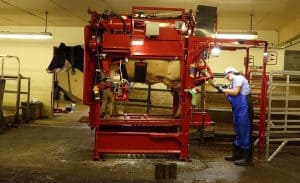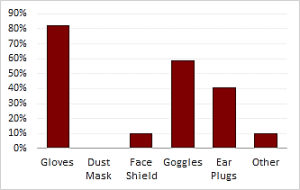SEPTEMBER 2019
Dr. Gerard Cramer is one of our colleagues that knows dairy cows well – right down to the hooves.
 Prior to joining the University of Minnesota – College of Veterinary Medicine, Dr. Cramer owned a foot health specific veterinary practice and today his research focuses on figuring out what causes lameness in cows, hoof trimming, and ensuring the health of hoof trimmers.
Prior to joining the University of Minnesota – College of Veterinary Medicine, Dr. Cramer owned a foot health specific veterinary practice and today his research focuses on figuring out what causes lameness in cows, hoof trimming, and ensuring the health of hoof trimmers.
Hoof trimmers work on a variety of farms and are exposed daily to topical antibiotics mainly tetracycline. However they are a population of livestock workers whose health has not previously been studied. One disease the hoof trimmers might be at increased risk for is multi-drug resistant Staphylococcus aureus (MRSA). MRSA can cause bacterial infections that can lead to serious illness in humans. Certain occupations such as veterinarians and livestock workers have been shown to be at an increased risk of infection with methicillin-susceptible SA (MSSA) and methicillin-resistant SA (MRSA).
UMASH awarded Gerard and his MPH student a pilot project grant for a closer look at the potential antimicrobial resistance impact facing hoof trimmers. The study titled “Impact of Daily Exposure to Tetracycline by Hoof Trimmers on MRSA and resistance profiles” was the work of Gerard Cramer, David Moe and Srinand Sreevatsan at the University of Minnesota.

Figure 1: Frequency of personal protective equipment use by 41 hoof trimmers
Hoof trimming is an inherently dangerous job and using additional PPE could play an important factor in not just reducing exposure to antibiotics but also reducing the number of injuries that occur to hoof trimmers. This project illustrates that hoof trimmers might have a different resistance profile compared to other people and the knowledge from this project will guide both health care and public health officials working with Staphylococcus aureus infections in agricultural communities. Furthermore the project highlights a need for the development of practical health and safety protocols for hoof trimmers .
UMASH’s efforts in protecting farmers and workers in agriculture find this information useful in our outreach with animal agriculture. In addition, the dairy industry will benefit from the development of health and safety protocols for workers.
Thanks to Dr. Cramer and team for putting their research to practice in the dairy industry – right down to the hooves.

 Gerard Cramer/Hoof Trimming pilot project
Gerard Cramer/Hoof Trimming pilot project